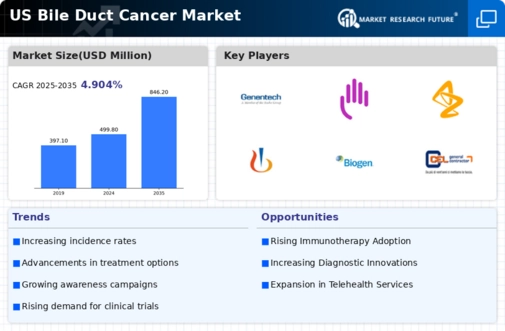Increased Awareness and Education
Increased awareness and education regarding bile duct cancer are pivotal in shaping the market landscape. Campaigns aimed at educating the public about the symptoms and risk factors associated with bile duct cancer have gained traction. Organizations such as the American Cancer Society play a crucial role in disseminating information, which may lead to earlier diagnosis and treatment. As awareness grows, more patients are likely to seek medical attention, thereby increasing the demand for diagnostic and therapeutic options in the bile duct-cancer market. This heightened awareness could potentially translate into improved survival rates and a more robust market for related healthcare services.
Emergence of Personalized Medicine
The emergence of personalized medicine is transforming the bile duct-cancer market. Tailored treatment approaches based on individual genetic profiles are becoming increasingly prevalent. This shift towards personalized therapies is supported by advancements in genomic sequencing and biomarker identification, which allow for more effective treatment strategies. The market for personalized medicine is projected to reach $2 trillion by 2025, indicating a substantial opportunity for growth within the bile duct-cancer market. As healthcare providers adopt these personalized approaches, patients may experience improved treatment outcomes, thereby driving demand for innovative therapies and contributing to the overall expansion of the market.
Rising Incidence of Bile Duct Cancer
The increasing incidence of bile duct cancer in the US is a primary driver for the bile duct-cancer market. According to the American Cancer Society, bile duct cancer cases have been on the rise, with an estimated 8,000 new cases diagnosed annually. This trend is likely attributed to factors such as obesity, chronic liver disease, and exposure to certain chemicals. As the population ages, the prevalence of risk factors associated with bile duct cancer may further escalate, leading to a growing patient population. Consequently, this surge in cases is expected to drive demand for innovative treatment options and diagnostic tools within the bile duct-cancer market, thereby stimulating market growth and attracting investment in research and development.
Growing Investment in Cancer Research
Investment in cancer research is a significant driver for the bile duct-cancer market. Public and private funding for cancer research has seen a notable increase, with the National Cancer Institute allocating approximately $6 billion annually for cancer research initiatives. This funding supports the development of novel therapies and clinical trials specifically targeting bile duct cancer. As research progresses, new treatment modalities may emerge, potentially transforming the therapeutic landscape. The influx of capital into research not only fosters innovation but also enhances collaboration among academic institutions, pharmaceutical companies, and healthcare providers, thereby propelling the bile duct-cancer market forward.
Advancements in Diagnostic Technologies
Technological advancements in diagnostic tools are significantly impacting the bile duct-cancer market. Innovations such as endoscopic retrograde cholangiopancreatography (ERCP) and advanced imaging techniques like MRI and CT scans have improved the accuracy of bile duct cancer diagnoses. These technologies enable earlier detection, which is crucial for effective treatment. The market for diagnostic imaging is projected to grow, with estimates suggesting a value of over $40 billion by 2026. As healthcare providers increasingly adopt these advanced diagnostic methods, the bile duct-cancer market is likely to benefit from enhanced patient outcomes and increased treatment uptake, ultimately driving market expansion.























Leave a Comment